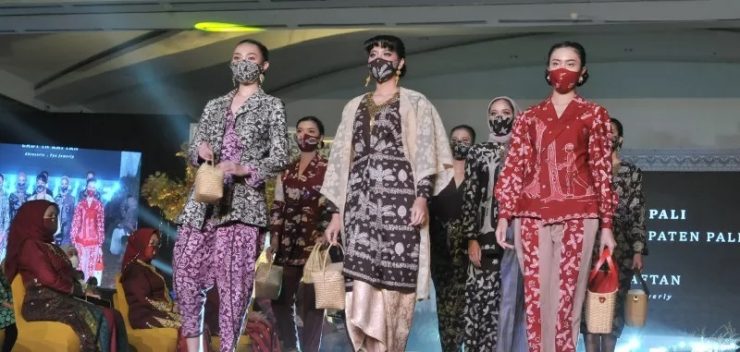INDONESIA is a country with abundant cultural wealth and diversity, both in the form of archaeological sites to high-value works of art such as traditional fabrics. If used properly and carefully, it can bring economic value that is beneficial to the community.
One form of cultural wealth that is used for the fashion industry includes batik, songket and weaving from various regions with different motifs. If the fabric is an original product, not a print, then the selling value is high.
Professor of the Faculty of Cultural Sciences, University of Indonesia, Prof. Dr. Lilawati Kurnia, S.S., M.A. said traditional Indonesian fabrics have the same potential economic value as tourism if they are taken seriously.
“Promoting archipelago fabrics can also be in line with regional tourism development, as long as what is introduced is not only the types of fabrics that are already well known. Should seriously handle and call the experts who are really experts. What is developed is also what is not yet known,” said Prof. Lilawati.
Prof. Lilawati gave an example, Iban Dayak ikat weaving is one of the archipelago’s heritage fabrics that is starting to become rare. In addition to the small number of new generation craftsmen, materials for fabric dyeing are also difficult to obtain because they are natural dyes.
According to Prof. Lilawati, ikat cloth is mostly marketed in Malaysia and is better known there. World collectors are also many who hunt for these fabrics and are bought at high prices or prices for collectibles.
For Prof. Lilawati, fabrics with ancient motifs and laden with the area of a place, need to be seriously developed. Because, this is able to increase the economic value of the craftsmen.
“So, there are two parallel things to be advanced, because traditional motifs, kumo motifs must also be preserved. So, for example, to attract young consumers, but for world collectors, look for the traditional ones, the old ones,” Prof. Lilawati underlined.
Consumer education
Almost all Indonesian people have at least one clothing made from traditional fabrics. Most are also able to distinguish between batik cloth, woven or songket, however, not a few who do not understand which is the original fabric and the print.
Fabrics with printed batik, woven and songket motifs, are usually sold at low prices. Meanwhile, fabrics made by craftsmen are more expensive because the process takes a long time.
“What is important is educating consumers that handicrafts are expensive. If the craft takes a long time to make and is complicated, there must be a price, if general consumers want it cheap, they use asphalt woven (fake original) or metered cloth,” Prof. Lilawati noted.
Education in the community about traditional cloth is said to be taken seriously. Because many craftsmen are threatened with bankruptcy because they cannot survive.
Prof. Lilawati believes that education about traditional fabrics and their development for the fashion industry must be carried out in collaboration with various fields such as tourism, industry and education.
“The weavers are generally old, they should be included in the school curriculum in weaver areas, otherwise it will take a long time,” Prof. Lilawati remarked.
Global taste design
Meanwhile, the National Chairman of the Indonesian Fashion Chamber (IFC) as well as a player in the homeland fashion industry, Ali Charisma said that to reach the international market with traditional fabrics, the fashion designs offered must be of global taste or that the world community likes, not only Indonesia.
Ali assessed, currently most of the fashion designs that use traditional fabrics are only for the country. In fact, designers can follow color trends and fashion styles abroad but use traditional motifs.
“Immediately work on traditional fabrics with a more global taste. Of course, the shape must be very simple, think of it like clothes in Indonesian malls, foreign brands everywhere can survive because the taste is global, so there is everything,” Ali pointed out.
Ali said the market for traditional Indonesian fabrics in the world is very wide and many are looking for it. The uniqueness of the motifs of each region can also be explored further for higher economic value to come.
Ali also said that to target the middle market, which has a fairly large and global purchasing power, using motifs inspired by local culture is legal compared to following world trends but has no elements to Indonesia.
“It’s not that we don’t support Small, Medium Enterprises (SMEs). For SMEs that use weaving and hand-drawn batik, it’s limited. Economically, this will be difficult to pursue globally, price too, consistency too. So, I think it’s different if the goal is to preserve culture by increasing the economy,” he continued.
New innovation
Most traditional fabrics usually have motifs that have been inherited by their ancestors. There is nothing wrong with this, but to reach young people or a wider range of consumers, new innovations are needed in terms of motif design and still maintain old-fashioned motifs for high-end consumers or collectors.
Old-fashioned motifs will forever be sought after by high-end consumers and collectors, but new innovations will make traditional fabrics fresher with different colors.
Certain institutions are needed from the government or other parties to provide textile designers or traditional designers to train craftsmen so that later they are able to create motifs that are in tune with global trends.
“So, the product can be enjoyed and contemporary, so it is not outdated,” Ali added.
Ali hopes that there will be young people who have a passion for creating new motif designs that can be distributed to craftsmen so as to generate new selling points. [antaranews]
















